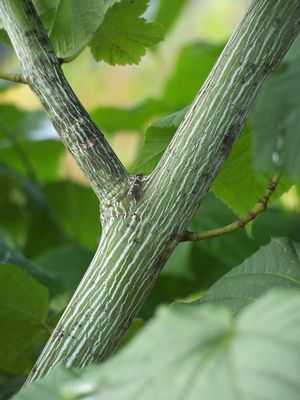View All Plants :: View All TREES
Acer tegmentosum 'Joe Witt'
Manchustriped Maple
Plant Type:
TREESAcer tegmentosum ‘Joe Witt’ – 'Joe Witt' is probably the best Manchustriped Maple. Another of the Snakebark Maples, it is even better than A. t. ‘White Tigress’ with more white stripes in the green bark. From the distance a quite pale white affect in the landscape especially in winter is apparent especially if set before evergreens. Somewhat open in youth it will grow into an oval to a more rounded form at maturity. The three to five-lobed leaves change from the summer light green to an autumn tone of light yellow or gold. The attractive strings of samaras dangle into fall. Site ‘Joe Witt’ in light shade planted in fertile, draining soil. Protect from afternoon sun. Protect the trunk from winter sun as winter blast can be an issue. For gardeners towards the northern end of its range spring planting is advised. Established potted Manchustriped Maple, cutting grown.
More About Acer tegmentosum 'Joe Witt'
- White Pin-striped Green Bark
- Butter Yellow Autumn Leaves
- Four Seasons Appeal
- Medium Sized Specimen
Characteristics and Attributes for Acer tegmentosum 'Joe Witt'
Season of Interest (Flowering)
- Spring / Summer / into Autumn
Season of Interest (Foliage)
- Spring / Summer / Autumn
Interesting Bark
- Striped
- Colored
Autumn Interest
- Fruit / Berries / Seed Heads
- Autumn Leaf Color
Light
- Morning Sun / Afternoon Shade
- Dappled Shade
Attributes
- Specimen
Growth Rate in the Garden
- Medium
Soil
- Fertile
Origins
- China
Propagated By
- Cutting Grown
Genus Overview: Acer
So many maples, so little time! There are an extraordinary number of very good species in Aceraceae, many of smaller stature that fit well in smaller landscapes and gardens of any size. Most have multi-season appeal and, indeed, these are the ones to which we at Quackin’ Grass Nursery gravitate. Most are content in fertile draining soils sited in full sun. Others are happier in the part sun conditions akin to the understory stature as suggested by their size. Through the years we have found that many maples when planted in the far northern end of the USDA hardiness range respond well to protection during at least their first winter - preferably more - in the landscape, i.e. use tall stakes set firmly in the ground with burlap attached completely barricading the tree. All of our maple offerings are cutting grown; these plants are not grafted.


